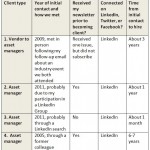8 lessons from my marketing mishaps
As I reflect on 2014, I’ve learned some lessons that may help you. Two of my anchor clients—clients who gave me work at regular intervals—took their work in-house last year. Although a couple of one-time projects replaced that income temporarily, I eventually fell behind. Catching up would have been easier if I’d done some things differently.
Lesson 1: Don’t stop marketing
Complacency plus unrealistic expectations. That’s what hurt me.
On the complacency front, I had stopped actively contacting new prospects because I had plenty of work. I didn’t want to have to turn away work that I was too busy to take on. I did, however, continue raising people’s awareness of me in a general way via social media, my blog, my weekly and monthly e-newsletters, and public speaking.
As for unrealistic expectations, I’d dreamed that publishing my book, Financial Blogging: How to Write Powerful Posts That Attract Clients, would sweep my business to new heights. Publishing my book was a wonderful experience. I’m thrilled by the enthusiastic reviews from my readers. I’m confident that it has brought me to the attention of new people. However, the book hasn’t directly created scads of new business for me.
Lesson 2: Use LinkedIn to meet targeted prospects
Following the advice of some fellow writers, I experimented with sending letters of introduction (LOIs) to a group of prospects. I used LinkedIn’s search function, focusing on keywords, to identify people who might hire me. Then I sent a letter of introduction via LinkedIn that focused on how I could help them, rather than how they could help me.
I gained three new clients from LOIs in 2014. Though some may call that a low success rate, it nicely complemented clients gained from other sources.
Lesson 3: Be politely persistent
People can’t hire you if they don’t have a need. That’s why polite persistence pays by keeping you in front of your prospects until they’re ready to hire.
When I meet people, I ask if I can add them to the distribution of my monthly e-newsletter of practical communications tips tailored to financial professionals. It’s great if I can win their permission to enter their email inbox. Sometimes that gentle reminder is the key to winning new business. However, I don’t add people without their permission. My newsletter has been an ongoing source of new business for me.
If somebody sounds like a great prospect for me, I try to follow up quarterly with a quick email asking about current needs. When possible, I share a link to an article of interest to that person. I’ve gained work this way, too.
Lesson 4: Go with the flow when new opportunities arise
Sometimes opportunities take you in new directions. In 2014, my opportunities to speak for pay to professional associations and corporate clients increased dramatically. It felt as if most of these opportunities fell into my lap. However, in every case I had some sort of personal connection with the organization through my newsletter, social media, or previous speaking engagements.
Feeling very pleased with the response I received from my audiences, I shared the information via social media and in my newsletters. Talking about my paid speaking gigs generated more opportunities. In fact, one time a simple tweet saying that I’d like more paid speaking gigs led directly to a new opportunity, as I described in “Secrets of a speedy sale via Twitter.”
Lesson 5: Try something new
I wondered about offering new products or services to attract business from individuals instead of large companies, which spurred me to offer my first self-sponsored paid webinar. In June 2014 I delivered a webinar version of “How to Write Investment Commentary People Will Read,” which I’ve also presented to CFA societies and corporate clients.
I was pleased with the enrollment and student participation. The technology drove me crazy, but that’s another story, which I’ve described in “Tech tips for your educational webinar–Learn from my experience.”
The webinar helped me indirectly, too, by giving me something to talk about with prospects and others.
Not every new initiative paid off with big sales. I’m glad I created Investment Commentary: Best Tips from InvestmentWriting.com, but it took time to recoup my production costs. It’s hard to make a significant amount of money from selling inexpensive items in a narrow niche.
Lesson 6: Fine-tune your old techniques
My newsletter has been the foundation of my success, but sign-ups have lagged somewhat over the past year or so. As I discussed in “Your call-to-action choice makes a difference,” I initially thought the position of my call-to-action box was a problem. I moved the box back to the upper right-hand corner of my website. That seemed to help some. Still, new newsletter sign-ups lagged previous levels.
I mulled over adding a pop-up newsletter subscription box to my website. I don’t like them on the other people’s websites, but people whom I respect reported that pop-ups boosted their sign-ups. I heard this from Michael Kitces of Nerd’s Eye View, Blane Warrene, and fellow writers. Dave Grant of Finance for Teachers boosted my interest further when he guest-blogged for me on “How and Why to Use Sliding Pop-ups.”
I added the free SumoMe pop-up at the end of September 2014. Since then my newsletter sign-ups have increased. About one-third to two-thirds of my newsletter sign-ups come via the pop-up, according to my weekly reports.
Lesson 7: Track your results
Look at what techniques have yielded new clients in the past. I describe my approach to this analysis in “Learn what works in winning clients.” I’m able to write this blog post because I look at which tactics yield new clients.
I wish there were a quick and easy formula for me to win new clients. But there isn’t. My new clients come from a diverse array of sources including referrals, my newsletter, my LOIs, and my general presence on the Web. One new client told me, “I see your name everywhere.”
Lesson 8: Get your focus right
Your website should clearly communicate your business focus. If it doesn’t, you’ll get inquiries from people who aren’t a good fit for your services and products.
I’m still working to get this right. My online presence attracts more individual advisors than marketers and other managers from larger investment and wealth management firms, the ideal clients for my writing and editing services.
This mismatch is my own doing. I like writing blog posts that help individuals learn how to write better. My book, Financial Blogging: How to Write Powerful Posts That Attract Clients, is a self-help manual for these folks. I can’t stop writing this kind of content because I enjoy it too much. I also get satisfaction from my paid speaking gigs about “Writing Effective Emails” and “How to Write Investment Commentary People Will Read” for local groups of the CFA Institute and Financial Planning Association.
It’s time to tweak my website messaging. Emphasizing my white paper and commentary work to attract more ideal clients is on my “to do” list for 2015.
What about YOU?
Do you see ways that these lessons might apply to you? What are you doing to fine-tune your marketing this year?
Image courtesy of KROMKRATHOG at FreeDigitalPhotos.net
Note: updated on September 23, 2021





Good and practical lessons.
+ patient and persistence. A nice and big tree doesn’t grow short time.
Andre